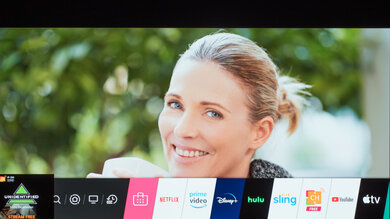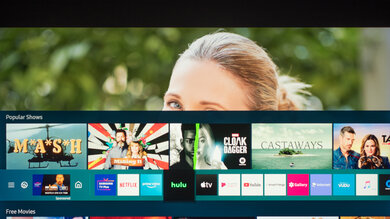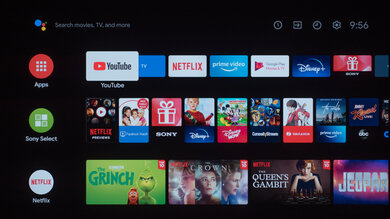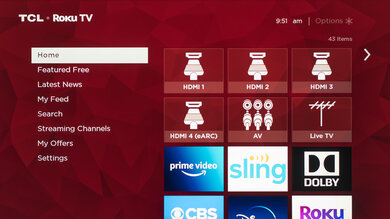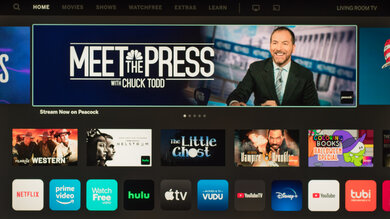A TV's smart platform may not be the first thing you consider when looking for a new TV, but each one has its own features, interface, and app store. Here's our overview of the major smart platforms to help you figure out which platform will best suit your needs.
Test results
WEBOS (LG)
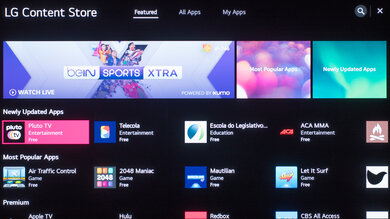 The LG Content Store, as seen on the LG BX OLED
The LG Content Store, as seen on the LG BX OLEDSince its introduction in 2014, LG's webOS has given other smart platforms a run for their money thanks to its intuitive user interface and unobtrusive design. The home menu appears as a colorful ribbon along the bottom of the screen that's split between apps, inputs, and settings. WebOS version 5.0, released with 2020 models like the LG CX OLED, is similar to previous versions with a powerful voice control feature that can perform advanced searches and communicate with compatible smart home devices. Most higher-end LG TVs come with LG's Magic Remote, which can be used as a traditional remote or a motion-controlled pointer, a feature unique to LG that makes navigation quick and easy. It's not the smallest remote, but it feels comfortable and everything is clearly labeled.
Overall, the interface is smooth and fast, and LG's content store has a wide selection of apps to download. Unfortunately, the menu and app store have ads and suggested content that can't be disabled, but they're not overly intrusive. One of the biggest limitations of webOS is that LG doesn't update older models to new versions of the OS, so you're limited to whichever version comes with that year's TV lineup.
For its 2021 lineup, LG has announced the biggest overhaul to webOS since its inception. Version 6.0 will have a completely redesigned home page, trading in the bottom ribbon for a new smart hub with various widgets, and a redesigned Magic Remote. We'll update this article once we test the new TVs and have a better idea of how the new version operates.
You can see our recommendations for the best LG TVs as well as a summary of their smart features here.
TIZEN OS (SAMSUNG)
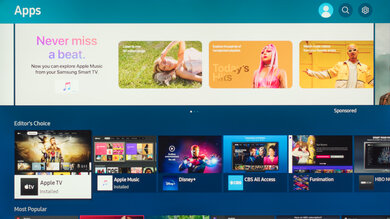 Samsung's app store, as seen on the Samsung Q80/Q80T QLED
Samsung's app store, as seen on the Samsung Q80/Q80T QLEDTizen is the proprietary OS on Samsung TVs. It features a Smart Hub navigation bar along the bottom of the screen, which lets you navigate your apps and change inputs and settings. Tizen is equipped with Samsung's Bixby smart assistant, which can integrate with compatible Samsung smart home devices. In 2020, Samsung updated Tizen OS with a more subdued color scheme, fewer animations, and a simpler menu design. Samsung smart remotes can look a little different depending on the model, but they function similarly and generally feel very premium and sleekly designed, especially on high-end models like the Samsung Q900TS 8k QLED. The remotes have been simplified in recent years to remove media hotkeys and number keys, and most of them don't require line of sight to the TV, which is convenient.
The smart interface on Samsung TVs is generally smooth, though some lower-end models like the Samsung TU7000 don't run quite as smoothly as high-end models with more powerful processors, like the Samsung Q90/Q90T QLED. Samsung's app store is also extensive and easy to navigate. Like webOS, there are ads and sponsored content on the home screen, and unfortunately, you can't disable them.
You can see our recommendations for the best Samsung TVs as well as a summary of their smart features here.
ANDROID TV (SONY, HISENSE, OTHERS)
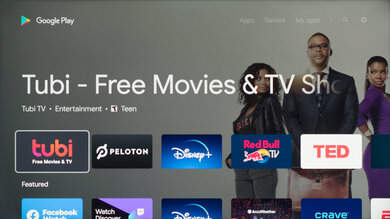 The Google Play store, as seen on the Sony X900H
The Google Play store, as seen on the Sony X900HSony and Hisense, as well as other brands like Sharp and Philips, mostly run on Android TV, along with a handful of TCL models. Like its smartphone counterpart, Android TV offers more customizability, with rows that can be removed or adjusted to your liking, and access to the Google Play store, which has maybe the widest selection of apps available. The platform isn't as intuitive as other smart interfaces, but users should have no problem navigating it after some getting used to. Sony TVs also have quick-access menus that you can customize with your favorite apps, which makes going from one to another even faster. Android TV also has an advanced voice control function that integrates with Google Assistant.
Android TV is generally quite smooth and its performance has improved significantly since earlier versions, especially on high-end Sony models like the Sony A8H OLED. The interface isn't quite as smooth on Hisense TVs like the Hisense H9G, but all in all, they have almost all of the same features.
Android used to stand out from other platforms by having an ad-free interface with the option to opt-out of suggested content, but starting in 2019, Google added a row of sponsored content that can't be disabled. While there's a workaround, we've also received reports that it's no longer working.
In 2021, new TVs from Android TV brands like Sony will come with Google TV, an upgraded successor to Android TV with an overhauled design. While Google TV is expected to eventually replace Android TV completely, it's unclear whether older models will be upgraded to the new platform. In any case, we'll update this article once we test the 2021 TVs that come with Google TV.
You can see our recommendations for the best Sony TVs as well as a summary of their smart features here.
ROKU TV (TCL, HISENSE, OTHERS)
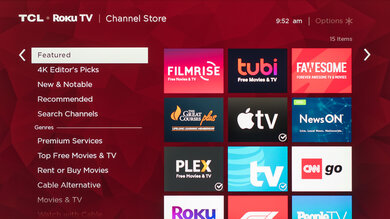 The Roku Channel Store, as seen on the TCL 6 Series/R635 2020 QLED
The Roku Channel Store, as seen on the TCL 6 Series/R635 2020 QLEDRoku started as a standalone streaming device that you could plug into your non-smart TV to access a variety of streaming apps, called 'channels' on Roku's interface. Since then, Roku has been integrated to become a smart TV OS in its own right. Most of TCL's lineup runs on Roku TV, but you can also find it on some Hisense models and other TV brands like Sharp. Roku TV remotes are as clean and simple as you'd expect, with just enough buttons to navigate the interface and some dedicated shortcut keys to certain apps. That said, the lack of buttons can be a bit too limited for some, as you can only access settings or voice control through the app.
Roku is great if you don't want anything overly complicated, since its interface is very clean, simple, and easy to use. The design is pretty basic, but that's not a bad thing, and it even lets you customize the theme to your liking, unlike other platforms. The Roku Channel Store gives you access to all major streaming apps and many others. Like other platforms, Roku TV includes ads that are sometimes large and hard to avoid. There's no way to opt-out, unfortunately.
You can see our recommendations for the best TCL TVs as well as a summary of their smart features here.
SMARTCAST (VIZIO)
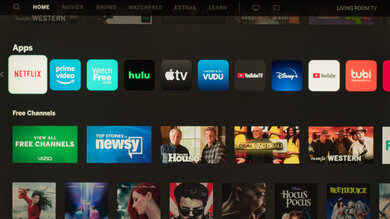 Vizio TVs come with pre-installed apps, seen here on the Vizio P Series Quantum 2020
Vizio TVs come with pre-installed apps, seen here on the Vizio P Series Quantum 2020Vizio's dedicated SmartCast platform has improved since it was first introduced, but still leaves a lot to be desired compared to other smart platforms. Vizio TVs now have a more traditional home screen and pre-'installed' apps like Netflix, Amazon Prime Video, and Disney+, but it's not the fastest or most stable interface because it's almost entirely web-based. None of the apps are actually stored on the TV, and instead, the interface simply gives you access to online versions of each app. For that reason, SmartCast doesn't have an app store to download additional apps, since none of the apps are actually downloaded to begin with. It's also one of the few platforms that doesn't support voice control.
Vizio may be the only smart platform left that is ad-free, aside from some suggested content, which can be disabled. While the platform has its limitations, it's perfectly suitable if you just want to launch an app and watch TV, as long as you don't mind having to rely on web-based versions of your favorite streaming apps. That said, it's not the smoothest or fastest, as it can be buggy and lag at times.
You can see our recommendations for the best Vizio TVs as well as a summary of their smart features here.
What about standalone streaming devices?
While they're increasingly hard to find, non-smart (or 'dumb') TVs are still out there. Major TV manufacturers began producing smart TVs exclusively for their mid- to high-end models around 2015, but some lesser-known or budget brands, as well as older TVs, don't come with a smart platform. These require a standalone box like a Google Chromecast, Apple TV, NVIDIA Shield, or Roku device to access streaming apps as a smart TV would. These devices are a great alternative if you have an older TV or simply prefer the simplicity of a non-smart TV. Gaming consoles can also fill a similar role, as most of them offer many of the same apps that can be found on a smart TV.
Amazon Fire TV
One of the most popular standalone streaming devices is the Amazon Fire TV stick, which is affordable and gives you access to tons of apps and media. Amazon also offers Fire TV as an integrated smart OS, but unlike Roku's OS, which can be found on a variety of brands and models, Fire TV is limited to select Insignia and Toshiba models. It's much more common as a standalone device, but TVs that bridge the gap like the Toshiba Fire TV 2020 are at least worth considering if you're a fan of Amazon's platform.
Conclusion
Smart TVs have become the standard, so your next TV is more than likely to come with one smart platform or another. Most of them are just fine if all you want is access to your favorite apps and TV shows, but not all smart platforms are created equal. Some are complex and customizable, like Android TV, others are smooth and straightforward, like webOS or Tizen, and still others offer total simplicity and ease-of-use, like Roku TV. You may prefer one over another, but it's also important to remember that most of your time will likely be spent watching TV rather than browsing apps, so as long as a TV meets your needs, you can't really go wrong with any of these platforms.
For options, check out our recommendations for the best smart TVs.
